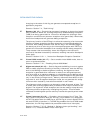
Vol. 3 2-7
SYSTEM ARCHITECTURE OVERVIEW
2. Loads the task register with the segment selector for the new task.
3. Accesses the new TSS through a segment descriptor in the GDT.
4. Loads the state of the new task from the new TSS into the general-purpose
registers, the segment registers, the LDTR, control register CR3 (base address of
the paging-structure hierarchy), the EFLAGS register, and the EIP register.
5. Begins execution of the new task.
A task can also be accessed through a task gate. A task gate is similar to a call gate,
except that it provides access (through a segment selector) to a TSS rather than a
code segment.
2.1.3.1 Task-State Segments in IA-32e Mode
Hardware task switches are not supported in IA-32e mode. However, TSSs continue
to exist. The base address of a TSS is specified by its descriptor.
A 64-bit TSS holds the following information that is important to 64-bit operation:
• Stack pointer addresses for each privilege level
• Pointer addresses for the interrupt stack table
• Offset address of the IO-permission bitmap (from the TSS base)
The task register is expanded to hold 64-bit base addresses in IA-32e mode. See
also: Section 7.7, “Task Management in 64-bit Mode.”
2.1.4 Interrupt and Exception Handling
External interrupts, software interrupts and exceptions are handled through the
interrupt descriptor table (IDT). The IDT stores a collection of gate descriptors that
provide access to interrupt and exception handlers. Like the GDT, the IDT is not a
segment. The linear address for the base of the IDT is contained in the IDT register
(IDTR).
Gate descriptors in the IDT can be interrupt, trap, or task gate descriptors. To access
an interrupt or exception handler, the processor first receives an interrupt vector
(interrupt number) from internal hardware, an external interrupt controller, or from
software by means of an INT, INTO, INT 3, or BOUND instruction. The interrupt
vector provides an index into the IDT. If the selected gate descriptor is an interrupt
gate or a trap gate, the associated handler procedure is accessed in a manner similar
to calling a procedure through a call gate. If the descriptor is a task gate, the handler
is accessed through a task switch.
2.1.4.1 Interrupt and Exception Handling IA-32e Mode
In IA-32e mode, interrupt descriptors are expanded to 16 bytes to support 64-bit
base addresses. This is true for 64-bit mode and compatibility mode.


















